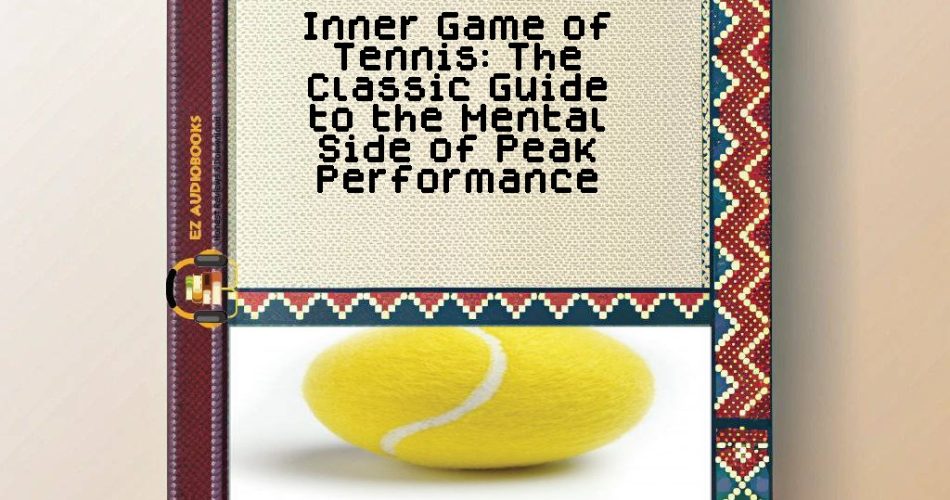Audiobook Sample
Listen to the sample to experience the story.
Please wait while we verify your browser...
- Title: Inner Game of Tennis: The Classic Guide to the Mental Side of Peak Performance
- Author: W. Timothy Gallwey
- Narrator: Dan Woren
- Length: 04:36:00
- Version: Abridged
- Release Date: 08/01/2008
- Publisher: Random House (Audio)
- Genre: Sports & Recreation, Non-Fiction, Self Development, Health & Wellness, Psychology, Other
- ISBN13: 9.78E+12
As I pressed play on “The Inner Game of Tennis” audiobook during my morning commute to campus, I found myself transported back to my graduate school days at Berkeley, where I first discovered how profoundly performance psychology intersects with literary analysis. The parallels between achieving flow state in tennis and achieving narrative immersion in literature are more striking than one might initially presume.
Dan Woren’s narration immediately establishes an authoritative yet calming presence, his baritone voice carrying Gallwey’s wisdom with the perfect balance of gravitas and approachability. There’s a rhythmic quality to his delivery that mirrors the very concepts being discussed – the natural ebb and flow of concentration, the dance between effort and ease. His performance reminds me of how my Japanese literature professor in Tokyo would read haiku, allowing just the right amount of space between phrases for the meaning to resonate.
Gallwey’s groundbreaking work, originally published in 1974, remains astonishingly relevant in our age of digital distraction. His central thesis about the ‘inner game’ – the mental battle against self-doubt and overthinking – transcends its tennis court origins. As someone who has spent decades analyzing narrative structures across cultures, I’m particularly fascinated by how Gallwey frames the mind as both protagonist and antagonist in our personal growth stories. The concept of Self 1 (the critical, analytical mind) versus Self 2 (the intuitive, capable body) creates a compelling character dynamic worthy of Shakespearean drama.
The audiobook shines brightest in its practical applications. Gallwey’s advice about ‘non-judgmental awareness’ immediately brought to mind my Comparative Literature seminar where we analyzed how different translations of Murakami’s work affected our interpretations. Just as my students learned to observe translation choices without immediate critique, Gallwey teaches athletes to observe their strokes without self-criticism – a transferable skill that has since transformed how I approach both literary criticism and my occasional tennis matches with colleagues.
Woren’s narration excels during the book’s more technical sections, his clear enunciation and measured pacing making complex psychological concepts accessible. However, I occasionally found myself wishing for slightly more vocal variation during extended analogies – a minor critique in an otherwise stellar performance. The production quality is excellent, with crisp audio that maintains consistency throughout.
What fascinates me most is how Gallwey’s principles anticipate contemporary mindfulness movements while remaining grounded in practical athletic experience. His emphasis on ‘letting it happen’ rather than ‘making it happen’ echoes Eastern philosophies I’ve studied, yet he presents these ideas without exoticism or appropriation. This balance makes the work particularly valuable in our current cultural moment where wellness advice often veers between hyper-rational productivity hacking and vague spiritualism.
Compared to more recent entries in the performance psychology genre like Mark Manson’s “The Subtle Art of Not Giving a F”uck”, Gallwey’s approach feels less contrarian but more universally applicable. Where Manson deliberately provokes with his language and tone, Gallwey persuades through quiet wisdom. Both valuable approaches, but Gallwey’s work has stood the test of time precisely because of its gentle authority.
For academic listeners like myself, the audiobook offers rich material for interdisciplinary connections. I’ve already incorporated several of Gallwey’s concepts into my ‘Literature and Performance’ seminar, where we examine how writers from Samuel Beckett to Haruki Murakami depict the psychology of mastery. The chapter on ‘Changing Habits’ particularly resonates with my research on how readers form interpretive habits that can either limit or liberate their engagement with texts.
If I were to offer one critique, it would be that the tennis-specific examples, while necessary for the book’s original audience, might momentarily lose listeners from other disciplines. However, Woren’s engaging delivery and Gallwey’s skillful analogies quickly bridge these gaps. By the final chapters, even this literature professor found herself applying tennis metaphors to her writing process.
The audiobook’s relatively short duration (just under two hours) makes it ideal for repeated listening. I’ve returned to key sections before important lectures and committee meetings, finding Gallwey’s advice as relevant to academic performance as to athletic achievement. The chapter on ‘Trusting the Self’ has become something of a personal mantra during particularly challenging writing sessions.
With scholarly appreciation and a renewed serve,
Prof. Emily Chen

